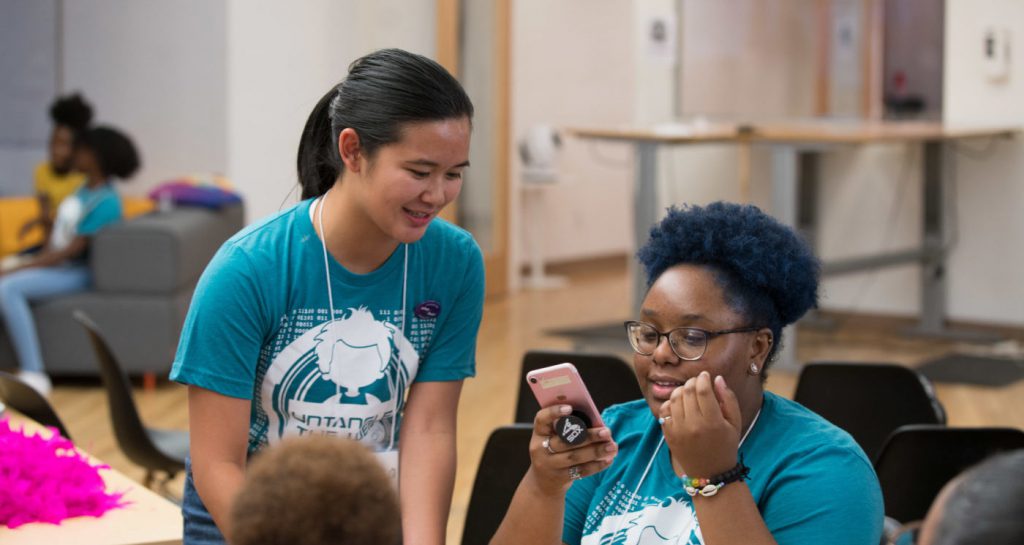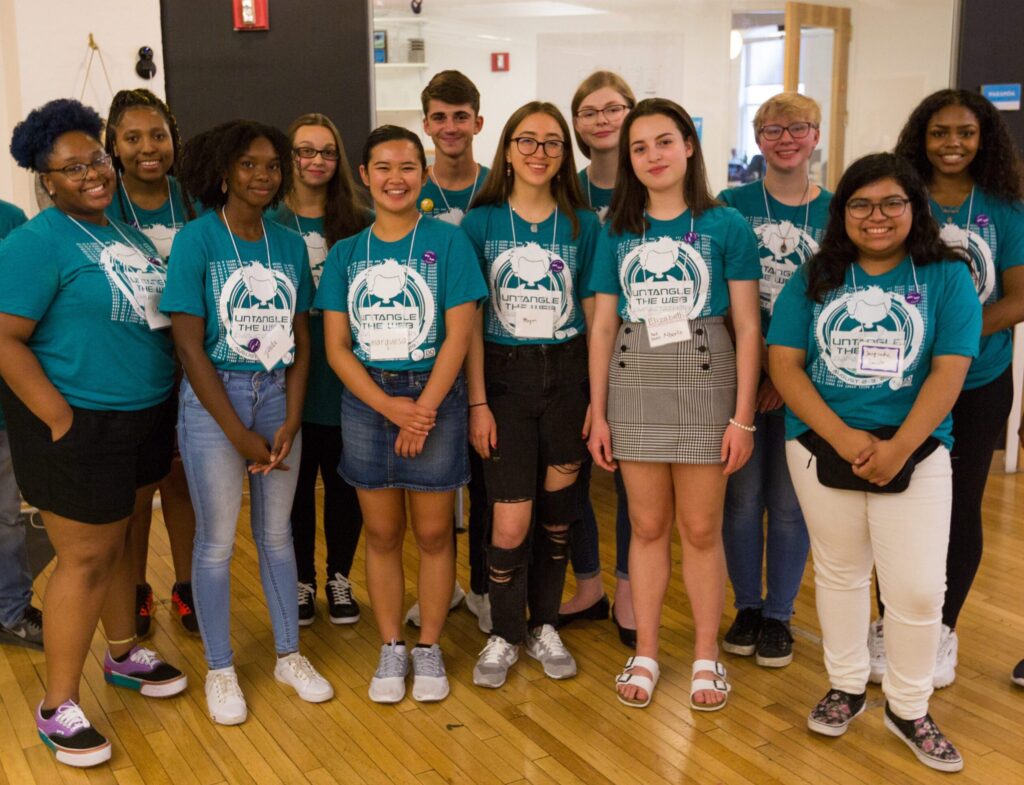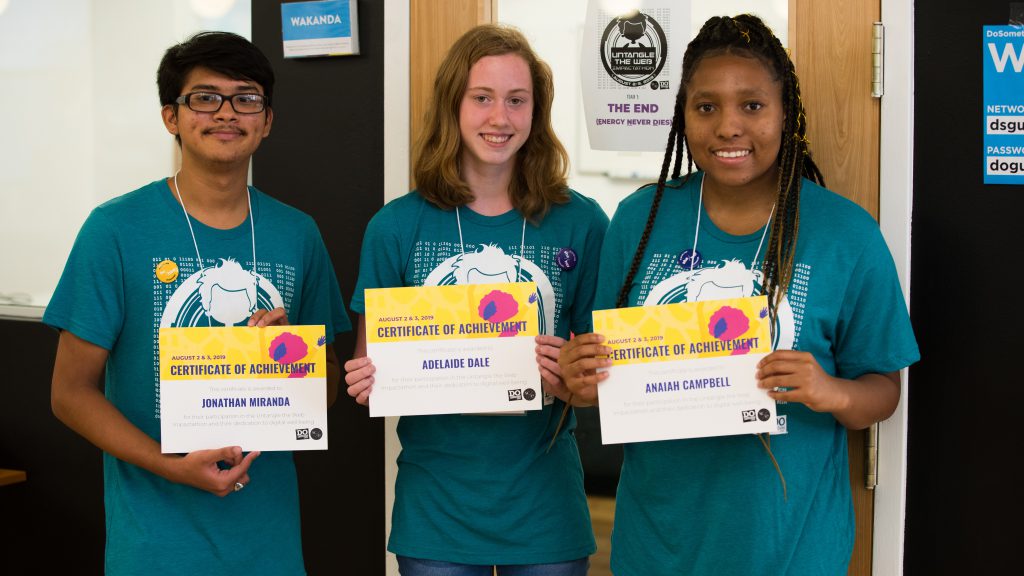We asked teens how to exercise better judgement online. Their responses blew us away.
“How might we improve people’s judgement in digital spaces?”
This was the question that guided the Untagle the Web hackathon, a two-day event we hosted this summer in collaboration with DoSomething.org. We gathered 15 exceptional young people who had expressed an interest in improving online life and asked them to develop a wireframe for a tool that would do just that.
Untangling the web
Last year, we partnered with DoSomething to develop Untangle the Web, a campaign designed to kickstart intergenerational conversations about digital life. DoSomething asked young people to take a quiz about how they used technology and media. Based on their responses, they received a digital personality and an action guide to help them start a conversation with an adult in their life. Whether a News Detective battling misinformation or a Ray of Sunshine spreading positive vibes, each young person shared an insight about their relationship with technology with a trusted adult.
Through this campaign, we aimed to reach 25,000 young people. Fifty-five thousand took the quiz.
Clearly, this project struck a chord with youth. We saw that young people recognized the effects that technology had on their lives and were desperate for resources that would help them navigate online environments.
Building on this momentum, we identified a small subset of the most engaged teens and asked them to apply for a hackathon—a two-day event where they could actually design a product that would help their peers untangle the web. We selected 15 of the most promising applicants from around the country and flew them out to New York City to participate.

Designing a mobile application to improve judgement in digital spaces. © DoSomething.org
The Hackathon
Working in small groups under the guidance of DoSomething mentors, these 15 teens developed wireframes for products that addressed our challenge question: “How might we improve people’s judgement in digital spaces?” They then presented their ideas to a panel of judges with diverse experiences in technology:
- Samarth Bhaskar, Senior Editor for Digital Transition Strategy, the New York Times
- Ross Dakin, adjunct professor of computer science, Lehman College
- Tej Gokhale, Civic Action Lead, DoSomething.org
- Jerelyn Rodriguez, co-founder, The Knowledge House
- Calvin Stalvig, Director of Youth Programming, Beam Center
We wanted to make sure our participants had plenty of space to develop their own ideas, so we only had a few requirements. Products had to be feasible, with a well-articulated problem, simple solution, and clear distinction from applications already on the market. They had to be functional, with a fleshed-out user experience. Lastly, they had to be integrated with existing online platforms.
Working in teams of three, our participants developed five product ideas:
- Thinklight: a chatroom that connects users with mental health professionals.
- ZiN: a bot that sends users daily affirmations that reinforce positive behaviors.
- VeriLegit: an application that uses existing databases to judge the accuracy of online media.
- HideOut: a service that clarifies who will see the personal information that users share.
- BullyBeeGone: a program that automatically hides and deletes abusive comments and messages on social media.

The 15 participants. © DoSomething.org
What did we learn?
This inspiring group of youth taught us so much about how young people today relate to technology. Here are our main takeaways.
- Young people want their voices to be heard. Over and over again, the young participants expressed appreciation that adults were making space for their ideas—and their leadership. Knowing that their voices are truly valued can encourage young people to get involved.
- These issues resonate with participants. The 15 young people we invited to the hackathon care deeply about online interaction. They also believe that online spaces could function better for young people—and that they’re perfectly capable of fixing them. These people were willing to spend a summer weekend working hard to make the internet better. They skipped their optional breaks to do it. And they designed five really, really impressive products.
- Diverse solutions empower more users. In the selection process, we prioritized participants that came from different geographies, races, socioeconomic backgrounds, and gender and sexual identities. This group clearly recognized that issues of online judgement don’t operate in a vacuum, and proposed solutions that took identity into consideration.
- Good online judgement means something different to everyone. We encouraged our participants to relate this topic to their own lived experiences. This allowed the cohort to focus on the specific issue or multiple issues that they felt were most pressing—and led to a diverse set of solutions. These participants didn’t necessarily agree on a single definition of “online judgement.” We think that’s a good thing. The one thing our participants did agree on? That it shouldn’t just be on them to exercise good judgement—tech companies have a responsibility to promote it.

The BullyBeeGone team. © DoSomething.org
What comes next?
Based on a set of criteria that included functionality, user experience, and potential for impact, our panel of judges selected BullyBeeGone as the official winner of the hackathon. Over the next few months, DoSomething will work with BullyBeeGone’s young designers to develop a minimum viable product (MVP) that will bring this great idea one step closer to the market. We’re excited by BullyBeeGone’s potential and thrilled that young people themselves are involved at every step of the design process.
Young people have really good ideas—and they’re willing to share them. It’s up to us to listen and to help them bring those ideas to fruition. In partnership with organizations like DoSomething, we’re striving to elevate youth voice and unlock young people’s potential as true agents of change.
We Untangled the Web with DoSomething.org. Here’s What We Learned.
More than 50,000 young people signed up to teach adults about digital life
Today’s young people are digital natives; they grew up with unmatched access to technology. However, they can feel disconnected from adults around technology and disempowered as members of the digital community. That’s a problem.
So what can we do? We know that fostering communication between a young person and an adult is critical for vibrant digital communities. So in March we partnered with DoSomething.org to kickstart intergenerational conversations about digital life. The goal was to reach 25,000 young people. After two months and more than 50 million social media impressions, 55,000 signed up to Untangle the Web.
Call to Action: DoSomething asked young people to take a quiz that asked them questions about how they use technology and media. At the end of the quiz, young people received a digital personality and an action guide curated to that personality to help them start the conversation with an adult in their life. Whether a News Detective battling misinformation or a Ray of Sunshine spreading positive vibes, each young person shared a piece of their life with those closest to them.
The Approach: Empower young people. DoSomething has found that operationalizing the “teach-to-learn” model by positioning young people as the experts has proven efficacy for behavior change and cause impact. They structured messaging around the positive behaviors they know young people exhibit online as an entry point to deeper conversation with adults about digital citizenship.
Youth Experiences: We think it worked. Thousands of young people shared their stories with us. Here are just a few.
With the help of this guide, I am informing my teachers and peers of better ways to sift through the tidal wave of information that the internet provides, and in turn, lead to more productive discourse.
“I love to have debates with my peers at school. We discuss politics, religion, and various other topics. However, it becomes very annoying when other students cite information from a website that either makes up and distorts common information, fails to provide any credible sourcing, or does not disclose funding sources. With the help of this guide, I am informing my teachers and peers of better ways to sift through the tidal wave of information that the internet provides, and in turn, lead to more productive discourse.” – Keaton, 17
This campaign is important to me because social media has made it so hard for people to be happy being themselves.
“This campaign is important to me because social media has made it so hard for people to be happy being themselves.The high expectations due to bullying and rude comments has completely taken over this generation’s ability to be happy in their own skin. People believe that they can say anything online without it affecting anyone just because it is not face to face, but that is not true. I know that I still remember every mean thing that has been said about how I look or my personality. I know that I am not the only one. The online harassment crisis needs to stop in order for people to be truly happy in their own skin again.” – Savannah, 18
“Before coming across DoSomething.org, I never noticed a problem with the way our society consumes media. But after exploring further, it became clear to me that discerning real from fake information online is a skill that even the most tech-savvy young adults lack. So I looked for ways to know which headlines, images, and quoted testimonies are legitimate. The solutions — learning to read horizontally, taking on the responsibility to ask ourselves two or three questions about the legitimacy of a source, and considering the consequences of what we post. I see these solutions as tips for improving the quality of information we intake online, key ingredients for an improved news diet. Doing this will not only improve our society’s media literacy but will contribute to a healthier democracy where we do not divide ourselves or argue on the basis of fake propaganda. These repercussions of media illiteracy must be acknowledged. And I foresee DoSomething’s effort to shed light on this largely disregarded issue impactful for youth and adults alike.” – Lina, 18
What We Learned
1. Through pre-campaign surveys, we learned that young people consistently rank online habits and digital use as one of the most important in their lives.
2. Post campaign, 66% of participants said they are more likely to talk to adults about technology as a result of their participation in the campaign.
3. Overwhelmingly, young people want to learn from their friends how to develop healthy skills online.
4. When asked to identify which skills are most important for navigating digital life, young people said Critical Thinking; Positivity, Compassion, and Suspending Judgement; Clear Communication; and Self-Control.
5. Young people want to be part of the solution. In fact, when asked what resources would be helpful, Accessible Content and Mentorship, More Online Resources and Guides, and Friends Learning from Each Other’s Mistakes were the most common suggestions.

What Comes Next
We heard our young people. Now it’s time to do something about it. Next, DoSomething and SCE are hosting an “Impact-A-Thon” in New York City from August 2-3. Fifteen young people will come together to solve a critical question: How might young people exercise better judgement in digital spaces?
So join us. Follow along. It’s an “Impact”-A-Thon, resource generation for young people, by young people.
Follow @scefdn and @dosomething on Twitter and Facebook for updates.
